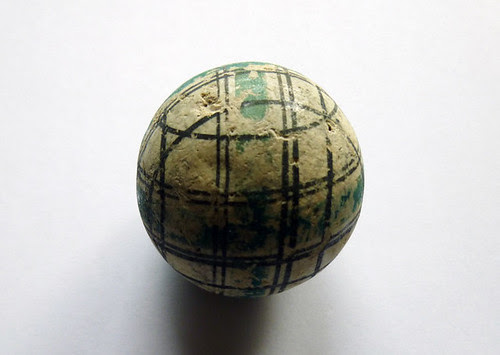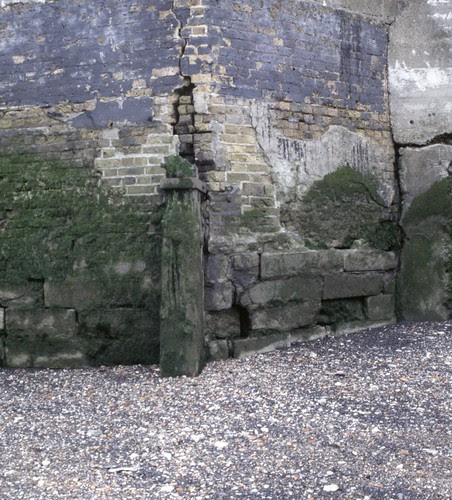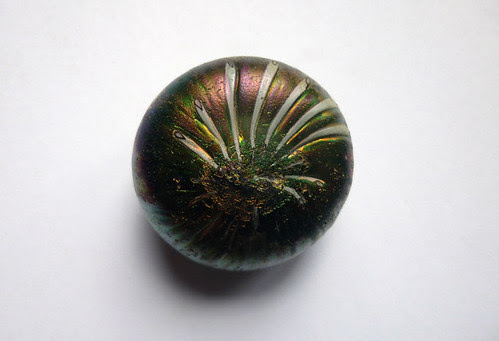Prehistoric forest at Erith, Bexley: photo by Nathalie Cohen, 17 November 2006 via Thames Discovery Programme
banked rubble, centuries deep
along the ghost-wharves
along the ghost-wharves
Trig, Broken, Kennett, Bell,
Allhallows, Queenhithe, Dyer's Hall
the scumbled edge unravelled
by fractious wavelets
surging with every
passing barge
each tide unpicking
this ragged seam
between Thames
and Thamesis
Londinium
and the City
wave-loosened shards
of the city's stone-
and earthen-ware
its brick and tile
smashed unremembered
histories washed out
with every tide, remixed
by the coiling waters
cast back, sucked in again
to the river's dark embrace
its deep encryption
Barry Taylor: from Foreshore Findings, 2014
Reused stones near Trinity Almshouse Stairs: photo by Mike Webber, 1996 via Thames Discovery Programme

Elizabeth I shilling, found in Thames foreshore by mudlarker John Higginbotham (Woolwich John): photo by John Higginbotham, 12 February 2014 via Thames Discovery Programme
Henry VIII silver coin, found in Thames foreshore by mudlarker John Higginbotham (Woolwich John): photo by Nick Stevens, 12 January 2012
via Thames Discovery Programme
Anglo-Saxon coin, found in Thames foreshore by mudlarker John Higginbotham (Woolwich John): The Fitzwilliam
Museum had this to say: 'This is an excellent example of the bust
Crowned type of Eadmund (939-46) by the Norwich moneyer Mainticen, who
also produced the bust Crowned type for Athelstan (924/5-39): photo by John Higginbotham, 12 February 2014 via Thames Discovery Programme
Spoon, found in Thames foreshore by mudlarker John Higginbotham (Woolwich John): photo by John Higginbotham, 12 February 2014 via Thames Discovery Programme
Bottle top, perhaps from an ink or medicine bottle (?), found in Thames foreshore by mudlarker John Higginbotham: photo by John Higginbotham, 16 March 2014 via Thames Discovery Programme

Gaming piece, marble, found in Thames foreshore by mudlarker John Higginbotham: photo by John Higginbotham and Nick Stevens, 15 October 2013 via Thames Discovery Programme
Neolithic beater, recovered from the Thames foreshore at Chelsea in the late 1990s: photo by Museum of London, 6 November 2008 via Thames Discovery Programme
Roman intaglio, found on the Southwark foreshore: photo by Museum of London, 20 May 1999 via Thames Discovery Programme
Something a bit Anthony Gormley about these cofferdam piles (Greenwich): photo by Nathalie Cohen, 2 February 2014 via Thames Discovery Programme
View of the medieval jetty (Greenwich): photo by Nathalie Cohen, 2 February 2014 via Thames Discovery Programme






















10 comments:
Barry Taylor, who's been a friend of this blog through thick and thin, has lately been getting muddy for a good cause. This is the first part of Barry's new eight-part poem "about the Thames foreshore, specifically the north-shore stretch between Millennium Bridge and Tower Bridge, for a project on clay and the history of the waterways. If you walk along that stretch at low-tide, it's like you're ankle-deep in ceramic fragments reaching back to the Roman occupation. An amazing archaeological resource. So the poem's a response to that..."
And a beautiful response at that.
Thank you Nin -- and agreed.
The poet Aram Saroyan writes back-channel that "Foreshore Findings" evokes the work of Basil Bunting for him; and we get that.
There's nothing quite like the act of slowly hunt-and-pecking-out a poem to help one enter its world. Barry's poem has opened the memory floodgates, here, to admit a remote period of dwelling in Bermondsey in the mid-1960s, at a time when the "ghost-wharves" had not yet quite given up all the ghosts, and the river's "dark encryption", as Barry so beautifully puts it, seemed to be carrying on business right along, as had been the case over the very many centuries since Aeneas or another sailed in, and began the long game of mudlarking and encrypting.
It's hard to think of the 19th century river without the sentences of Dickens -- particularly those of the early passages of Our Mutual Friend -- banging about in in one's head.
How did Londoners of that period hear those sentences?
On 2 May 1864 The Guardian greeted the first monthly instalment (30 pages) of the novel in terms that look forward to the final line of this first part of Barry's poem:
"Mr. Dickens's old horror of the dark river comes out again in the very first sentences. A man who gets his living fishing for dead bodies in the Thames is the first personage introduced.
"In the mystery concerning the disappearance of a certain Mr Harmon, who was to come over from the West Indies to inherit a large fortune and marry a young lady left to him under the will, there is already a good deal of interest.
"It is a body which is supposed to be his which is found by the river searcher when we first see him at his work. The clothes on it are identified and everything appears to show that the body is really that of Mr. Harmon, but perhaps some persons inclined to speculate will think that it may not be Mr. Harmon after all.
"In the opening passages, Mr. Dickens's early style reappears :
"'... A boat of dirty and disreputable appearance, with two figures in it, floated on the Thames as an autumn evening was closing in. The figures in this boat were those of a strong man with ragged grizzled hair and a sun-browned face, and a dark girl of nineteen or twenty. The girl rowed, pulling a pair of sculls very easily; the man, with the rudder-lines slack in his hands, kept an eager look-out. He had no net, hook or line, and he could not be a fisherman; and he could not be a waterman ... but his eyes watched every little race and eddy. She watched his face as earnestly as he watched the river. But, in the intensity of her look there was a touch of dread or horror.'"
One recalls that as late as the time (c. 1815) when John Keats was a young medical student residing marginally in that same precinct of London, his instructor in surgery, the widely renowned and highly respected Dr Astley Cooper, was, like others in the profession in the period, given to resorting, for the procurement of specimens to be used for dissecting in teaching, to the services of the corps of "resurrection men", who by night fished bodies out of the river (or sometimes from the immediate environs, and sometimes before actual expiration), and in the morning quietly carted them round to the back door of the hospital, for quick sale, no questions asked.
The Victorian Web site parses the more than somewhat macabre Dickens / Dark River connection in a bit more detail:
__
The foul and abhorrent graveyard described by Dickens in the last part of A Christmas Carol (1843) was but a small part of the problem metropolitans (those living in and around the City of London proper) had with waste removal in general. Compounding the problem of how dispose safely of the refuse of a metropolitan population of 3,000,000 at mid-century was the widespread use of the flush toilet and the abandoning en masse of the time-honoured chamberpot. The use of the flush toilet was initially regarded as a success for the Public Health Act of 1848, and its champion, Edwin Chadwick. The increased flow of sewage was not, however, properly treated before it was discharged. In just a few short years, the feces and urine of Londoners were overwhelming some 200,000 cesspits and thence the Thames itself (as well as through sewers directly after 1815), which from 1582 had been the city's principal source of drinking water.
The unusually hot June of 1858 precipitated the rapid growth in bacteria in the Thames and its tributaries, so that the House of Commons at Westminster, immediately beside the great river, could only meet if curtains soaked in chloride of lime were hung in the chamber. Before plans were realised to relocate Parliament upriver to Hampton Court and the law courts to Oxford and St. Albans, heavy rains obliterated the problem. But the government, knowing it had to act to avert a similar disaster in future summers, resolved to act through the Metropolitan Board of Works, and the next year accepted the proposal of engineer Joseph Bazalgette to create a comprehensive sewer system. The work continued until 1875. With much improved draining, the elimination of the cesspits, and the purification of the Thames, a second Great Stink was averted and the threat of cholera outbreaks much reduced. However, the process of reversing half-a-century of environmental neglect was sufficiently slow that the riverside scenes in Our Mutual Friend (1864-65), especially Marcus Stone's complementary mudflat illustration "The Bird of Prey Brought Down", must have rung all too true for Dickens's London readers even six years after the cessation of "The Great Stink." In Little Dorrit (Dec., 1855 — June, 1857) Dickens had deplored the present state of the once-mighty Thames, for the great commercial highway that enabled Britain to export its goods to the rest of the world and that was the fountainhead of the second British Empire, had become but a "deadly sewer" (Book 1, Chapter 3); this damning description thus anticipated the "Great Stink" that would follow by a year the conclusion of the novel's serial run:
"Miles of close wells and pits of houses, where the inhabitants gasped for air, stretched far away towards every point of the compass. Through the heart of the town a deadly sewer ebbed and flowed, in the place of a fine fresh river."
[continues]
Polluted and derelict, the nightmarish wasteland that Dickens and Phiz had five years earlier described verbally and visually in the August 1850 number of David Copperfield, Chapter 46, "The River", is still so evocative because it was based on close observation of a repulsive reality, the tidal flats at Westminster, in the novel rendered the more hideous by Dickens's emphasising the relatively recent rusting detritus of commercial shipping and the suggestion that a cesspit dating from the last great visitation of the Black Death in the seventeenth century was located in the vicinity:
"The neighbourhood was a dreary one at that time; as oppressive, sad, and solitary by night, as any about London. There were neither wharves nor houses on the melancholy waste of road near the great blank Prison. A sluggish ditch deposited its mud at the prison walls. Coarse grass and rank weeds straggled over all the marshy land in the vicinity. In one part, carcases of houses, inauspiciously begun and never finished, rotted away. In another, the ground was cumbered with rusty iron monsters of steam-boilers, wheels, cranks, pipes, furnaces, paddles, anchors, diving-bells, windmill-sails, and I know not what strange objects, accumulated by some speculator, and grovelling in the dust, underneath which — having sunk into the soil of their own weight in wet weather — they had the appearance of vainly trying to hide themselves. The clash and glare of sundry fiery Works upon the river-side, arose by night to disturb everything except the heavy and unbroken smoke that poured out of their chimneys. Slimy gaps and causeways, winding among old wooden piles, with a sickly substance clinging to the latter, like green hair, and the rags of last year's handbills offering rewards for drowned men fluttering above high-water mark, led down through the ooze and slush to the ebb-tide. There was a story that one of the pits dug for the dead in the time of the Great Plague was hereabout; and a blighting influence seemed to have proceeded from it over the whole place. Or else it looked as if it had gradually decomposed into that nightmare condition, out of the overflowings of the polluted stream."
[continues]
Eight years later, precisely when The Illustrated London News responded to the threat to public health which the Great Stink posed, Dickens's editorialist, Henry Morley, dealt with the twin issues of poor urban sanitation and Thames pollution in "A Way to Clean Rivers" in Household Words. Since the only name associated with any of the articles in Dickens's weekly journal was his own (Household Words. A Weekly Journal. Conducted by Charles Dickens.), the perspiring public of July 1858 has every reason to expect that the sentiments expressed in this column were Dickens's own. The article reflects upon the problem occasioned by the much increased volume of "sewerage" that Britain's rivers in general are having to contend with now that cesspits are passe:
"We pour it [the filth] out into the rivers flowing through our towns, and pollute them as never before have rivers been polluted since the world was rnade. The soot-coloured river at Manchester; the Tarne at Birmingham, a small stream which, even before reaching Birmingham, receives much of the animal refuse of two hundred and seventy thousand persons; may be said to contain in dry seasons, as much sewerage as water. The Thames which, before reaching Loudon, is polluted by the drainage from seven hundred thousand people, and in London deposits the filth of hundreds of thousands upon mud-banks exposed daily at low water, and in these hot days, festering at the heart of the metropolis. These rivers represent the difficulty that has to be met before the new order of things can be regarded as established with a proper harmony in all its parts. Tame water at Birmingham is drunk by fifty thousand people. Londoners now look for their Thames drinking-water in the cleanest places they can find ; but what are they that we should call them clean? Disease is begotten — fish are destroyed. The fish that had disappeared from the river at Leicester, have returnecl since measures were taken to remove the offence of the sewage. Such measures have been already attempted in twelve towns, by which tire evil could no longer be endured."
Anticipating the golden mounds of Our Mutual Friend, Morley argues that animal refuse has value as fertilizer, and therefore discharging far out to sea through an elaborate and extensive network of sewers such as has been proposed is in fact "wasteful": "Dirt itself is not gold, though industry may make it so" must have been an economically-based argument that many metropolitan rate-payers found attractive. Even though, he concedes, his scheme creating gardens on the banks of the Thames and fertilising these with lime-treated sewage would cost "three or four millions of pounds sterling", it would, he asserts, be vastly cheaper than extending the sewer system to Sea Reach.
Overwhelming post--all of it.
Many thanks, Vasilis.
I knew the temptation of poking about for odd scraps of the past in the muddy stumps of a prehistoric forest with an extensive sewerage history would prove irresistible to my fellow cognoscenti.
This post is now third in Google for the uncommon word "mudlarker". "(formerly) one who made a living by picking up odds and ends in the mud of tidal rivers", according to the Free Dictionary.
And TRENDING one would hope, at the very least.
(Thank you for the update, Michael.)
Post a Comment